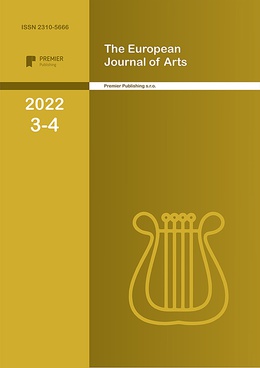Interpretation of Venus in Contemporary Italian Art
Authors
Lobskaia Anastasiia

Share
Annotation
Objective: The purpose of this work is to study the transformation of the image of the goddess Venus in contemporary Italian art. Various representations of the ancient deity were studied both in traditional and new types of fine art (installation, photography, video art, digital art).
Methods: The main methods were iconological and iconographic analysis, as well as a comparative approach.
Results: The author comes to the conclusion that from the second half of the 20th to the 21st century, the artists’ approaches to the image of Venus have changed significantly: if in the 20th century they tended to preserve the ancient image and worked with its semantic by changing the context, in the 21st century the very appearance of the goddess began to undergo transformation. In addition, it has been found that contemporary artists tend to adapt the most recognizable images of Venus, thus not working with deep narratives, but with clichés.
Scientific novelty: This work is the first study of its kind, for the first time including the most relevant works created by Italian authors in recent years.
Practical significance: The results of the study can be used to prepare review texts on contemporary Italian art, exhibition projects, and methodological materials.
Keywords
Authors
Lobskaia Anastasiia

Share
References:
- Getashvili N.V. “Vechnye obrazy” antichnosti i iskusstvo vtoroj poloviny XX - nachala XXI veka: opyt funkcional'nogo analiza. Journal of the Siberian Federal University. Series: Humanitarian Sciences, 2022, T.15, No.1, s. 9-22 (in Russian).
- Gombrich E. The Story of Art. London: Phaidon Press, 1995, 688 p.
- Fergonzi F. Arturo Martini e le ricerche sulla terracotta nei primi anni trenta. Annali della Scuola Normale Superiore di Pisa. Classe di lettere e filosofia. 1986, Serie III, Vol.16, N3, pp. 895-930 (in Italian).
- Lenyashina N.M. Plasticheskaya enciklopediya Arturo Martini. Scientific works, 2015, N33, s. 214-234 (in Russian).
- Kruglova T.A. "Sovremennaja klassika" ili "vechnaya sovremennost'": sravnenie dvuh temporal'nyh rezhimov razvitiya iskusstva v mezhvoennyj period (fashistskaya Italiya i SSSR). News of the Ural Federal University. Series 3: Social Sciences, 2019, T.14, N3(191), s. 63-71 (in Russian).
- Volli U. Donne di Casaboschi. Semiotica delle figure femminili di Casa Boschi Di Stefano. Milano: Skira, 2021, 110 p. (in Italian).
- Eco U. The Open Work. Cambridge, Massachusetts: Harvard University Press, 1989, 320 p.
- Minnucci R. Heaps of Rags and Double Visions. The Interpretation of the Classical Venus in Arte Povera. IKON. Journal of Iconographic Studies, 2020, N13, pp. 361 – 372.
- Elmo Raj, PP. Text and Meaning in Umberto Eco’s The Open Work. The Context, 2015, 2.3, pp. 326-331.
- Sechin A. Ikonograficheskij tip Venus Pudica kak plasticheskaya metafora zhenstvennosti v drevnem i novom iskusstve. The Art of Sculpture in the 20th – 21st Centuries: Masters, Tendences, Problems : collective monography. Moscow: BuksMArt, 2018, s. 452-463 (in Russian).
- Podolskaya K.S. Transformaciya skul'ptury kak vida iskusstva vo vtoroj polovine XX - nachale XXI veka. The Historical, Philosophical, Political and Legal Sciences, Culturology and History of Art. The Questions of Theory and Practice, 2017, N12-2(86), s. 159-163 (in Russian).


